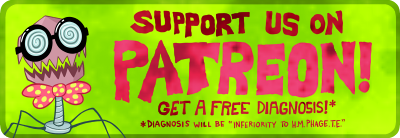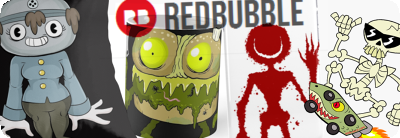Intermission: Minor Character Spotlights Part II: Corpse World!
I'm honestly still not sure just how I feel about the Corpse Zone story arc. I never meant for it to last more than a couple of weeks, a quick little "dungeon" in your own body to show off just how deep these zones and concepts can go, but it turned into pretty much an entire series of its own over the course of nearly a year, complete with its own visual style and more video-gamey logic.
Did we go too far off the rails? Maybe, though that's often my favorite part of any other series. I have to say I'm a bigger fan of the Thriller Barque story arc in One Piece than all the rest of One Piece put together, and I think it even holds up entirely on its own with or without an understanding of the rest of that series. I guess by ballooning a simple side quest into something so big, I at least proved to myself I was capable of actually building to a climax and wrapping up a storyline, which was a pretty important exercise for the comic itself.
Did we go too far off the rails? Maybe, though that's often my favorite part of any other series. I have to say I'm a bigger fan of the Thriller Barque story arc in One Piece than all the rest of One Piece put together, and I think it even holds up entirely on its own with or without an understanding of the rest of that series. I guess by ballooning a simple side quest into something so big, I at least proved to myself I was capable of actually building to a climax and wrapping up a storyline, which was a pretty important exercise for the comic itself.

Doctor E.M. Balmer
I've always loved "kid-safe" villains. Those bad guys who are just plain mean, grouchy, goofy and mostly ineffectual to the point of being more sympathetic than menacing. The purest form of this is The Gargamel; that rotten jerk who lives to terrorize some innocent community of tiny people, friendly monsters or talking animals.
The idea of a rotting corpse as a world with its own "people" had come to me long before Awful Hospital, and was almost the main focus of the series in the first place, and I knew it would have to have one of these dorky bad guys. What else would make sense in the rules I've established other than an embalming machine?
Balmer's personality is based heavily on Arktos, the "Gargamel" of the German-Australian series Tabaluga, and I think of him as having basically the same voice.
Balmer isn't even as "evil" as Arktos, though; he's just trying to fulfill his job, and as you may have caught from some dialog snippets, even the people he's constantly trying to murder don't really take any of it personally, I guess in much the same way that Bowser is still invited along for all that go-kart racing. It helps that, as also indicated by Balmer's speech patterns, he makes no distinction between what he loves and what he hates. The more he hates something, the more he loves it, and vice versa. He lives for his own misery, which we just might use to our advantage if when we ever see him again.
I'm also not really clear whether Balmer's "true form" is the machine body or the embalming fluid sloshing around inside it. It's probably a little of both.
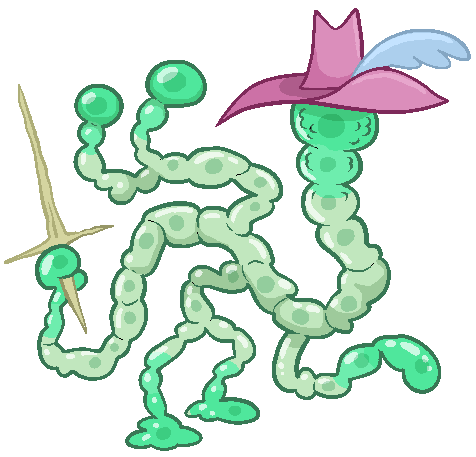
Maya Celia
If you've read and can at all follow my explanations for how this universe works, then you know that Maya Celia is simultaneously a normal, unintelligent mold growing in the literal, familiar version of Fern's dead corpse and this dashing rogue wandering the dungeon-world manifested by said corpse. There are also, however, other nonsapient fungi in Celia's version of reality, and maybe if you dug another zone deeper you could go adventuring with the people versions of those, too. It's complicated!
I had Celia's character and most of her backstory pinned down almost immediately, though at one point, I considered a reveal that she was really just a kid and she was really only LARPing all along. At one point, I considered the possibility that everyone in your corpse, including monster encounters, were all just in on one big RPG session Fern thought was real.
I still find this idea funny, but it would have ruined the emotional impact of the backstory I really wanted to give these characters.

Staph
Bacteria are, naturally, the "main" inhabitants of biovessels, the dominant people or the closest equivalent to humans. Giving them all little masks of keratin was a worldbuilding idea kind of out of left field, just because I wanted them to have a common design motif with a fantasy feel to it.
Staph does not represent a single bacterium, but a being manifested by one entire strain of staph bacteria in Fern's body, so in "our" world, Staphy exists as billions and billions of bacterial cells multiplying and dying inside of Fern every second, and every other bacteria-person we saw is similarly the concept-being for one strain of one species of bacterium.
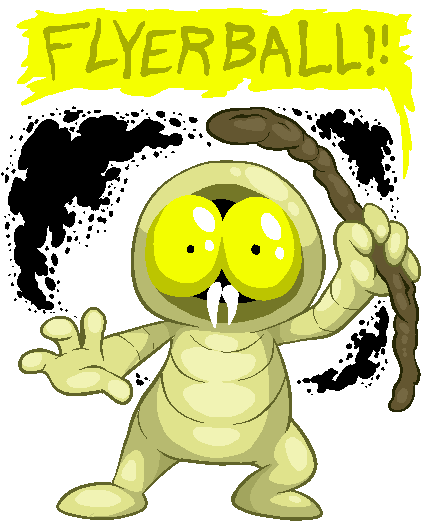
Maggie
In the same vein, Maggie's "species" represents all of a corpse's insect activity. As long as a dead body has maggots, its Biovessel Zone will have a being like Maggie or her mentor, Magatha.
Despite representing maggots, Maggie is an adult and Magatha was basically ancient. These beings spend many, many layers in their "maggot" form before dissolving into a gigantic swarm of tiny, mindless fly-like things they regard more like an "afterlife" than a metamorphosis, and their ability to control these "flies" is analagous to communing with the dead.
Up close, I think these "flies" would be ever-shifting, chaotic motes of prickly legs, black hairs and multifaceted eyes; roiling little balls of the Concept of Flying Insects. I think the next step in the life cycle would be these "flies" eventually finding another corpse zone, mingling with its flies, and filling up a trash can with their own dead bodies until a new maggot-being starts to grow inside.
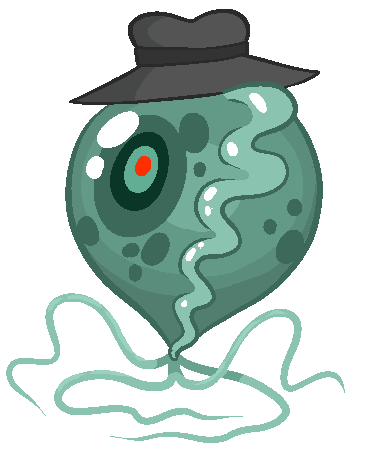
Tricia
I don't have a whole lot to say about Tricia, who was kind of a throwaway side villain, except that she is not the sexually transmitted Trichomonas vaginalis. There are actually several protozoa in this group that can be found as parasites or harmless freeloaders in the human body and other mammals.

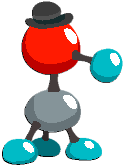
Methyl & Hyde
Balmer's two sidekicks are conceptual beings representing the methanol and formaldehyde in Balmer's fluids. This does mean that their root concepts are anchored to the same embalming fluid that I just said might be Balmer himself. This is perfectly normal for the zones, where you, too, could totally hang out with manifestations of your own molecular components, assuming you actually knew them personally and got along with them well enough. They may represent "your" molecular components, but they still have lives of their own out in the virtually infinite perception range!
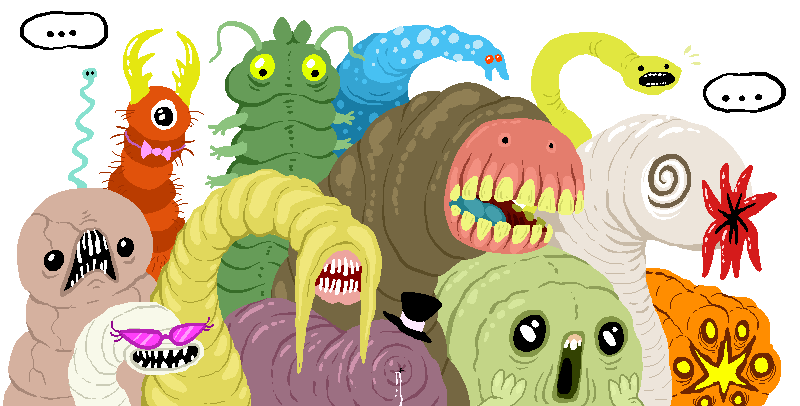
Worms
In the real world, "worm" is a term so broad it's almost meaningless. We use it to denote most, but not all boneless animals with elongated bodies, a set of criteria so common in nature that "worm" only slightly more specific than the word "creature" or "beast."
I have a solid idea by now of what I want "worm" to mean in this setting, but I might save it for its own short story or some cooler in-universe reading material, suffice to say that they are their own, distinct phenomenon associated with conceptual manifestation, and everything that exists in any form has its own worms in addition to any other associated conceptoids or zones.

The Biovessel Zone
While not a character, it's possible that a lot of people skimmed, forgot, or didn't totally understand the in-universe explanations for this setting, though I think most people more or less surmised how it works on their own.
If you do need an explanation, it's just that everything alive or in any way sentient has a zone connected with its body, loosely based on its anatomy. "Zone stuff," as we established, works in such a way that you can totally visit this world and explore different environments based on your organs and tissues, just as Fern got a little taste of.
It can go a lot further than that, of course; not only could you visit the cavernous maze that represents your own brain, but so could the being representing your own brain. Maybe the two of you could work together to track down and destroy the hideous, disgusting clot of blockage representing your debilitating, chronic procrastination problem, though that in itself might come in sentient being form on yet another layer and he might decide to show up and make the whole endeavor really awkward, because maybe he's actually nice and doesn't mean it. You don't know!
There are basically an infinite number of stories I could squeeze out of this, which makes sense, because exploring the magical land of your own rotting carcass was almost its own series idea, then an idea for a morbid children's book (Goosebumps age range) with a protagonist who ultimately has to solve their own murder.
I just might still do this.
The idea of a rotting corpse as a world with its own "people" had come to me long before Awful Hospital, and was almost the main focus of the series in the first place, and I knew it would have to have one of these dorky bad guys. What else would make sense in the rules I've established other than an embalming machine?
Balmer's personality is based heavily on Arktos, the "Gargamel" of the German-Australian series Tabaluga, and I think of him as having basically the same voice.
Balmer isn't even as "evil" as Arktos, though; he's just trying to fulfill his job, and as you may have caught from some dialog snippets, even the people he's constantly trying to murder don't really take any of it personally, I guess in much the same way that Bowser is still invited along for all that go-kart racing. It helps that, as also indicated by Balmer's speech patterns, he makes no distinction between what he loves and what he hates. The more he hates something, the more he loves it, and vice versa. He lives for his own misery, which we just might use to our advantage
I'm also not really clear whether Balmer's "true form" is the machine body or the embalming fluid sloshing around inside it. It's probably a little of both.

Maya Celia
If you've read and can at all follow my explanations for how this universe works, then you know that Maya Celia is simultaneously a normal, unintelligent mold growing in the literal, familiar version of Fern's dead corpse and this dashing rogue wandering the dungeon-world manifested by said corpse. There are also, however, other nonsapient fungi in Celia's version of reality, and maybe if you dug another zone deeper you could go adventuring with the people versions of those, too. It's complicated!
I had Celia's character and most of her backstory pinned down almost immediately, though at one point, I considered a reveal that she was really just a kid and she was really only LARPing all along. At one point, I considered the possibility that everyone in your corpse, including monster encounters, were all just in on one big RPG session Fern thought was real.
I still find this idea funny, but it would have ruined the emotional impact of the backstory I really wanted to give these characters.
I had Celia's character and most of her backstory pinned down almost immediately, though at one point, I considered a reveal that she was really just a kid and she was really only LARPing all along. At one point, I considered the possibility that everyone in your corpse, including monster encounters, were all just in on one big RPG session Fern thought was real.
I still find this idea funny, but it would have ruined the emotional impact of the backstory I really wanted to give these characters.

Staph
Bacteria are, naturally, the "main" inhabitants of biovessels, the dominant people or the closest equivalent to humans. Giving them all little masks of keratin was a worldbuilding idea kind of out of left field, just because I wanted them to have a common design motif with a fantasy feel to it.
Staph does not represent a single bacterium, but a being manifested by one entire strain of staph bacteria in Fern's body, so in "our" world, Staphy exists as billions and billions of bacterial cells multiplying and dying inside of Fern every second, and every other bacteria-person we saw is similarly the concept-being for one strain of one species of bacterium.

Maggie
In the same vein, Maggie's "species" represents all of a corpse's insect activity. As long as a dead body has maggots, its Biovessel Zone will have a being like Maggie or her mentor, Magatha.
Despite representing maggots, Maggie is an adult and Magatha was basically ancient. These beings spend many, many layers in their "maggot" form before dissolving into a gigantic swarm of tiny, mindless fly-like things they regard more like an "afterlife" than a metamorphosis, and their ability to control these "flies" is analagous to communing with the dead.
Up close, I think these "flies" would be ever-shifting, chaotic motes of prickly legs, black hairs and multifaceted eyes; roiling little balls of the Concept of Flying Insects. I think the next step in the life cycle would be these "flies" eventually finding another corpse zone, mingling with its flies, and filling up a trash can with their own dead bodies until a new maggot-being starts to grow inside.

Tricia
I don't have a whole lot to say about Tricia, who was kind of a throwaway side villain, except that she is not the sexually transmitted Trichomonas vaginalis. There are actually several protozoa in this group that can be found as parasites or harmless freeloaders in the human body and other mammals.


Methyl & Hyde
Balmer's two sidekicks are conceptual beings representing the methanol and formaldehyde in Balmer's fluids. This does mean that their root concepts are anchored to the same embalming fluid that I just said might be Balmer himself. This is perfectly normal for the zones, where you, too, could totally hang out with manifestations of your own molecular components, assuming you actually knew them personally and got along with them well enough. They may represent "your" molecular components, but they still have lives of their own out in the virtually infinite perception range!

Worms
In the real world, "worm" is a term so broad it's almost meaningless. We use it to denote most, but not all boneless animals with elongated bodies, a set of criteria so common in nature that "worm" only slightly more specific than the word "creature" or "beast."
I have a solid idea by now of what I want "worm" to mean in this setting, but I might save it for its own short story or some cooler in-universe reading material, suffice to say that they are their own, distinct phenomenon associated with conceptual manifestation, and everything that exists in any form has its own worms in addition to any other associated conceptoids or zones.

The Biovessel Zone
While not a character, it's possible that a lot of people skimmed, forgot, or didn't totally understand the in-universe explanations for this setting, though I think most people more or less surmised how it works on their own.
If you do need an explanation, it's just that everything alive or in any way sentient has a zone connected with its body, loosely based on its anatomy. "Zone stuff," as we established, works in such a way that you can totally visit this world and explore different environments based on your organs and tissues, just as Fern got a little taste of.
It can go a lot further than that, of course; not only could you visit the cavernous maze that represents your own brain, but so could the being representing your own brain. Maybe the two of you could work together to track down and destroy the hideous, disgusting clot of blockage representing your debilitating, chronic procrastination problem, though that in itself might come in sentient being form on yet another layer and he might decide to show up and make the whole endeavor really awkward, because maybe he's actually nice and doesn't mean it. You don't know!
There are basically an infinite number of stories I could squeeze out of this, which makes sense, because exploring the magical land of your own rotting carcass was almost its own series idea, then an idea for a morbid children's book (Goosebumps age range) with a protagonist who ultimately has to solve their own murder.
I just might still do this.
Staph does not represent a single bacterium, but a being manifested by one entire strain of staph bacteria in Fern's body, so in "our" world, Staphy exists as billions and billions of bacterial cells multiplying and dying inside of Fern every second, and every other bacteria-person we saw is similarly the concept-being for one strain of one species of bacterium.

Maggie
In the same vein, Maggie's "species" represents all of a corpse's insect activity. As long as a dead body has maggots, its Biovessel Zone will have a being like Maggie or her mentor, Magatha.
Despite representing maggots, Maggie is an adult and Magatha was basically ancient. These beings spend many, many layers in their "maggot" form before dissolving into a gigantic swarm of tiny, mindless fly-like things they regard more like an "afterlife" than a metamorphosis, and their ability to control these "flies" is analagous to communing with the dead.
Up close, I think these "flies" would be ever-shifting, chaotic motes of prickly legs, black hairs and multifaceted eyes; roiling little balls of the Concept of Flying Insects. I think the next step in the life cycle would be these "flies" eventually finding another corpse zone, mingling with its flies, and filling up a trash can with their own dead bodies until a new maggot-being starts to grow inside.
Despite representing maggots, Maggie is an adult and Magatha was basically ancient. These beings spend many, many layers in their "maggot" form before dissolving into a gigantic swarm of tiny, mindless fly-like things they regard more like an "afterlife" than a metamorphosis, and their ability to control these "flies" is analagous to communing with the dead.
Up close, I think these "flies" would be ever-shifting, chaotic motes of prickly legs, black hairs and multifaceted eyes; roiling little balls of the Concept of Flying Insects. I think the next step in the life cycle would be these "flies" eventually finding another corpse zone, mingling with its flies, and filling up a trash can with their own dead bodies until a new maggot-being starts to grow inside.

Tricia
I don't have a whole lot to say about Tricia, who was kind of a throwaway side villain, except that she is not the sexually transmitted Trichomonas vaginalis. There are actually several protozoa in this group that can be found as parasites or harmless freeloaders in the human body and other mammals.


Methyl & Hyde
Balmer's two sidekicks are conceptual beings representing the methanol and formaldehyde in Balmer's fluids. This does mean that their root concepts are anchored to the same embalming fluid that I just said might be Balmer himself. This is perfectly normal for the zones, where you, too, could totally hang out with manifestations of your own molecular components, assuming you actually knew them personally and got along with them well enough. They may represent "your" molecular components, but they still have lives of their own out in the virtually infinite perception range!

Worms
In the real world, "worm" is a term so broad it's almost meaningless. We use it to denote most, but not all boneless animals with elongated bodies, a set of criteria so common in nature that "worm" only slightly more specific than the word "creature" or "beast."
I have a solid idea by now of what I want "worm" to mean in this setting, but I might save it for its own short story or some cooler in-universe reading material, suffice to say that they are their own, distinct phenomenon associated with conceptual manifestation, and everything that exists in any form has its own worms in addition to any other associated conceptoids or zones.

The Biovessel Zone
While not a character, it's possible that a lot of people skimmed, forgot, or didn't totally understand the in-universe explanations for this setting, though I think most people more or less surmised how it works on their own.
If you do need an explanation, it's just that everything alive or in any way sentient has a zone connected with its body, loosely based on its anatomy. "Zone stuff," as we established, works in such a way that you can totally visit this world and explore different environments based on your organs and tissues, just as Fern got a little taste of.
It can go a lot further than that, of course; not only could you visit the cavernous maze that represents your own brain, but so could the being representing your own brain. Maybe the two of you could work together to track down and destroy the hideous, disgusting clot of blockage representing your debilitating, chronic procrastination problem, though that in itself might come in sentient being form on yet another layer and he might decide to show up and make the whole endeavor really awkward, because maybe he's actually nice and doesn't mean it. You don't know!
There are basically an infinite number of stories I could squeeze out of this, which makes sense, because exploring the magical land of your own rotting carcass was almost its own series idea, then an idea for a morbid children's book (Goosebumps age range) with a protagonist who ultimately has to solve their own murder.
I just might still do this.


Methyl & Hyde
Balmer's two sidekicks are conceptual beings representing the methanol and formaldehyde in Balmer's fluids. This does mean that their root concepts are anchored to the same embalming fluid that I just said might be Balmer himself. This is perfectly normal for the zones, where you, too, could totally hang out with manifestations of your own molecular components, assuming you actually knew them personally and got along with them well enough. They may represent "your" molecular components, but they still have lives of their own out in the virtually infinite perception range!

Worms
In the real world, "worm" is a term so broad it's almost meaningless. We use it to denote most, but not all boneless animals with elongated bodies, a set of criteria so common in nature that "worm" only slightly more specific than the word "creature" or "beast."
I have a solid idea by now of what I want "worm" to mean in this setting, but I might save it for its own short story or some cooler in-universe reading material, suffice to say that they are their own, distinct phenomenon associated with conceptual manifestation, and everything that exists in any form has its own worms in addition to any other associated conceptoids or zones.

The Biovessel Zone
While not a character, it's possible that a lot of people skimmed, forgot, or didn't totally understand the in-universe explanations for this setting, though I think most people more or less surmised how it works on their own.
If you do need an explanation, it's just that everything alive or in any way sentient has a zone connected with its body, loosely based on its anatomy. "Zone stuff," as we established, works in such a way that you can totally visit this world and explore different environments based on your organs and tissues, just as Fern got a little taste of.
It can go a lot further than that, of course; not only could you visit the cavernous maze that represents your own brain, but so could the being representing your own brain. Maybe the two of you could work together to track down and destroy the hideous, disgusting clot of blockage representing your debilitating, chronic procrastination problem, though that in itself might come in sentient being form on yet another layer and he might decide to show up and make the whole endeavor really awkward, because maybe he's actually nice and doesn't mean it. You don't know!
There are basically an infinite number of stories I could squeeze out of this, which makes sense, because exploring the magical land of your own rotting carcass was almost its own series idea, then an idea for a morbid children's book (Goosebumps age range) with a protagonist who ultimately has to solve their own murder.
I just might still do this.
I have a solid idea by now of what I want "worm" to mean in this setting, but I might save it for its own short story or some cooler in-universe reading material, suffice to say that they are their own, distinct phenomenon associated with conceptual manifestation, and everything that exists in any form has its own worms in addition to any other associated conceptoids or zones.

The Biovessel Zone
While not a character, it's possible that a lot of people skimmed, forgot, or didn't totally understand the in-universe explanations for this setting, though I think most people more or less surmised how it works on their own.
If you do need an explanation, it's just that everything alive or in any way sentient has a zone connected with its body, loosely based on its anatomy. "Zone stuff," as we established, works in such a way that you can totally visit this world and explore different environments based on your organs and tissues, just as Fern got a little taste of.
It can go a lot further than that, of course; not only could you visit the cavernous maze that represents your own brain, but so could the being representing your own brain. Maybe the two of you could work together to track down and destroy the hideous, disgusting clot of blockage representing your debilitating, chronic procrastination problem, though that in itself might come in sentient being form on yet another layer and he might decide to show up and make the whole endeavor really awkward, because maybe he's actually nice and doesn't mean it. You don't know!
There are basically an infinite number of stories I could squeeze out of this, which makes sense, because exploring the magical land of your own rotting carcass was almost its own series idea, then an idea for a morbid children's book (Goosebumps age range) with a protagonist who ultimately has to solve their own murder.
I just might still do this.
If you do need an explanation, it's just that everything alive or in any way sentient has a zone connected with its body, loosely based on its anatomy. "Zone stuff," as we established, works in such a way that you can totally visit this world and explore different environments based on your organs and tissues, just as Fern got a little taste of.
It can go a lot further than that, of course; not only could you visit the cavernous maze that represents your own brain, but so could the being representing your own brain. Maybe the two of you could work together to track down and destroy the hideous, disgusting clot of blockage representing your debilitating, chronic procrastination problem, though that in itself might come in sentient being form on yet another layer and he might decide to show up and make the whole endeavor really awkward, because maybe he's actually nice and doesn't mean it. You don't know!
There are basically an infinite number of stories I could squeeze out of this, which makes sense, because exploring the magical land of your own rotting carcass was almost its own series idea, then an idea for a morbid children's book (Goosebumps age range) with a protagonist who ultimately has to solve their own murder.
I just might still do this.

